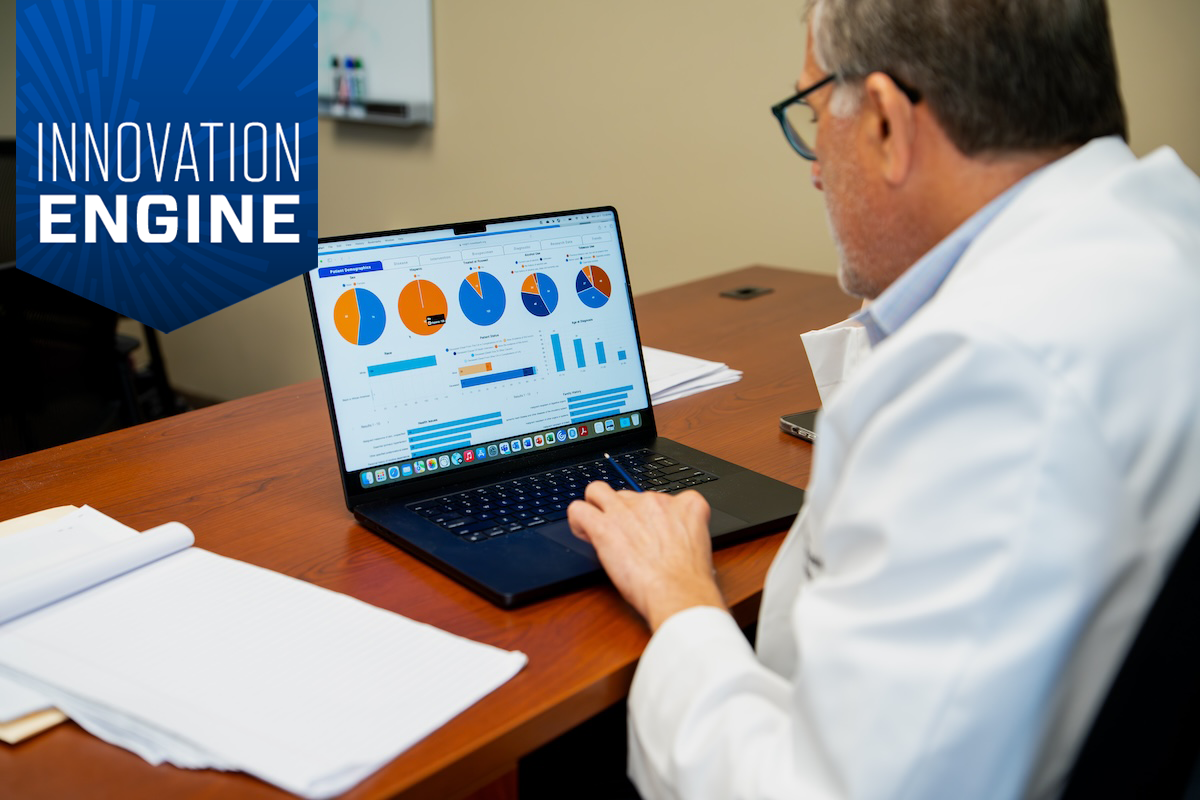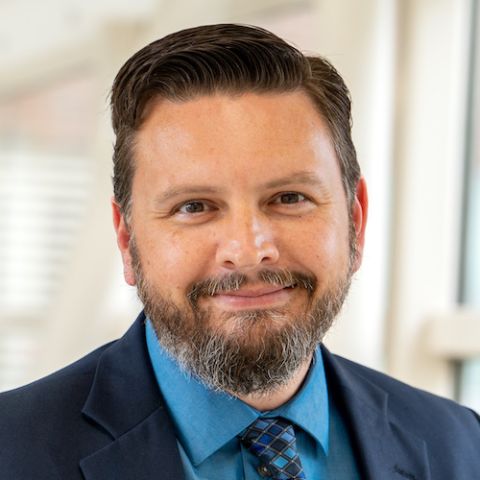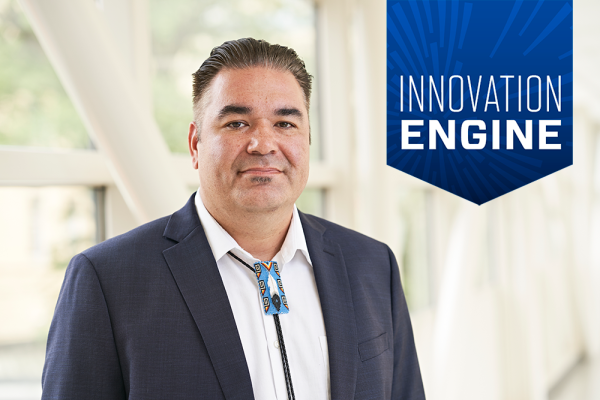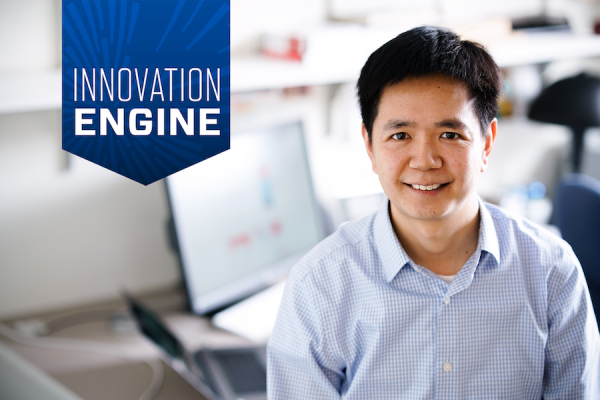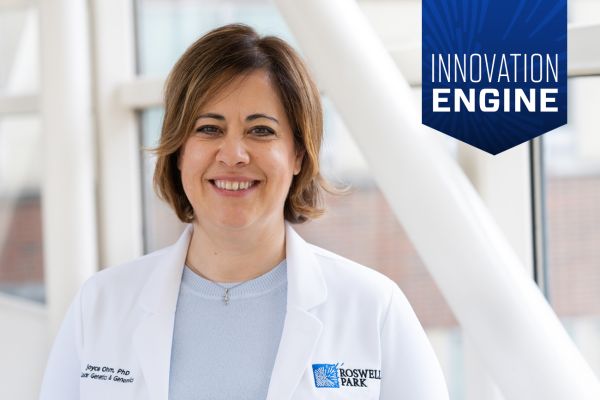Patients help drive one-of-a-kind nSight data portal, aiding the next breakthrough.
The Innovation Engine series highlights high-impact Roswell Park science that advances the priorities of the National Cancer Plan — a roadmap for working together to end cancer as we know it. The work outlined in this post supports Goal #7: Maximize Data Utility.
You may imagine a cancer researcher as someone peering through the lens of a microscope or culturing cells in a Petri dish. But that person is just as likely to work from a computer, reviewing mind-boggling volumes of data in the search for clues about why cancer begins and how it can be prevented or cured.
Consider the numbers: There are more than 200 types of cancer, more than 725 genes associated with cancer, more than 200 FDA-approved cancer drugs, thousands upon thousands of possible combinations of those drugs, and an endless number of questions: What factors increase the risk of developing specific cancers? Why are treatments effective in some patients but not others? What combinations of therapies work best? Numbers can reveal patterns that point the way to answers.
A one-of-a-kind software tool called nSight, developed by Roswell Park Comprehensive Cancer Center’s Center for Quantitative Imaging team and exclusive to the hospital, speeds the research process by sorting through data at astonishing speeds, even organizing information based on key patient characteristics, habits or demographics. In the field of statistics, the population being studied is represented as n — the "n" in nSight.
“It’s the best platform I have ever seen for tracking a patient’s journey and identifying groups of patients with similar journeys,” says Kenan Onel, MD, PhD, Chief of Clinical Genomics and Director of the Center for Precision Oncology and Cancer Prevention at Roswell Park.
Finding clues in the data to improve cancer treatment
The nSight data portal delivers information about more than 200,000 Roswell Park patients who gave permission for their medical records and biological samples to be used for cancer research. All the information is “de-identified” — stripped of personal details that could connect the data to a specific person. “This allows us to protect patient privacy while learning from the experiences of our patients using valuable and generously donated samples for research,” says Joyce Ohm, PhD, Chair of Cancer Genetics & Genomics.
nSight accesses electronic health records, cancer registries and other sources of information, including samples of blood and tissue stored in Roswell Park’s Data Bank and BioRepository; details of surgical and imaging procedures; lists of patients’ cancer and non-cancer medications; information about lifestyle, drawn from patient questionnaires; and records of clinical visits that provide a timeline of a patient’s progress before, during and after treatment.
Christopher Darlak, Deputy Chief Information Officer at Roswell Park, explains how nSight works. “One part of it involves data exploration. For example, let’s say I’m a lung cancer researcher. Our database includes more than 20,000 lung cancer cases. If I want to study just patients with non-small cell lung cancer, I can retrieve the latest data and then get really specific. I can sort those patients by gender, ethnicity, alcohol and tobacco use, age at the time of diagnosis, survival status. I can also look at patients with specific mutated genes.”
A second application focuses on building “cohorts,” or groups of patients who share various characteristics, so researchers can compare them and investigate differences such as survival rates.
Speedy answers help advance the science
The ability to identify statistical patterns quickly saves both time and money. Before launching a new research project, investigators need to determine whether they’re following a promising lead or heading toward a dead end, based on what they see in the data. “Researchers who have a hypothesis or idea can come here and test it out to see if it’s feasible,” says Darlak.
Before the introduction of nSight, researchers had to call the staff of Roswell Park’s Biomedical Research Informatics Shared Resource (BRISR) to ask for data about patients with certain characteristics and then wait to receive the spreadsheet. Narrowing the search even further required a second request, which slowed progress. While some projects still require manual data services provided by BRISR, nSight enables researchers to perform many basic searches from their own desktops and get the results immediately.
“It’s especially important as a first step for designing clinical trials or doing outcomes research,” says Matthew Cortese, MD, MPH, Assistant Professor of Oncology in the Departments of Medicine and Cancer Genetics & Genomics. As a starting point, he says, nSight makes it easy to access up-to-date information about how many patients with a specific diagnosis are seen each year at Roswell Park.
Mukund Seshadri, DDS, PhD, Chair of Oral Oncology and principal investigator of the nSight protocol, says nSight is similar to the NCI Cancer Research Data Commons. “It allows investigators to visualize and integrate data for their research.”
Created with financial support from Roswell Park’s Cancer Center Support Grant from the National Cancer Institute, nSight launched in September 2021. Since then it has supported more than 8,000 searches by more than 190 Roswell Park scientists, giving them an extraordinary advantage in the quest for answers. While it’s available only to Roswell Park teams right now, the possibility of expanding access to researchers at other institutions will be explored in the future.
The Roswell Difference
Pioneering innovation like this is part of what makes Roswell Park an "Exceptional" comprehensive cancer center, designated by the National Cancer Institute.
Dr. Onel says nSight makes it possible for investigators to study cancer as it evolves over time in a single patient, shedding light on how the disease is affected by both the patient’s genetic profile and exposure to therapy. “We can learn what factors are associated with tumor survival after therapy, and ultimately what factors are associated with drug resistance and relapse in that patient. This could help us learn what drives relapse on a more general basis, so we could anticipate and treat it before it ever occurs.”
“We have used nSight to identify rare tumor samples banked at Roswell Park and to ask important questions about how the cancer genome and epigenome drive the response to therapy,” adds Dr. Ohm. “This allows our scientists to study the genetic and molecular drivers of cancer initiation and progression, and understand how patients respond to various therapies.”
“The goal is to help our scientists produce the best science possible,” says Darlak. “Our development team uses Google-like technology that’s leading edge. When we bring new faculty on board and I introduce them to nSight, I always get the same response: ‘I’ve never seen anything like this before.’”
